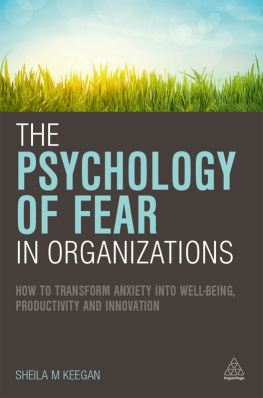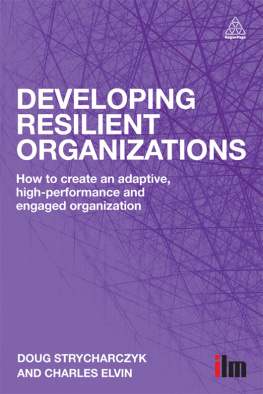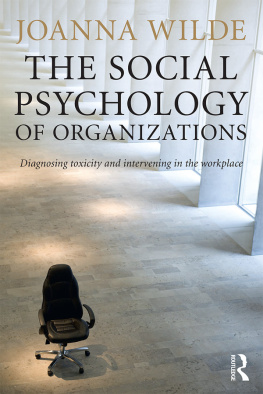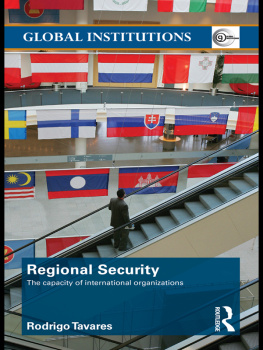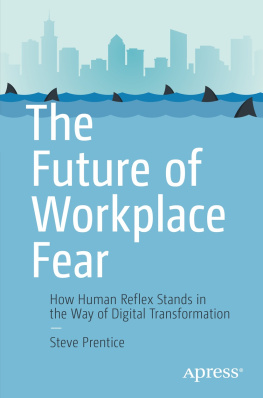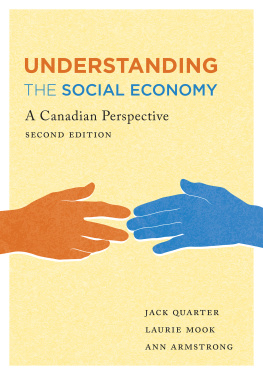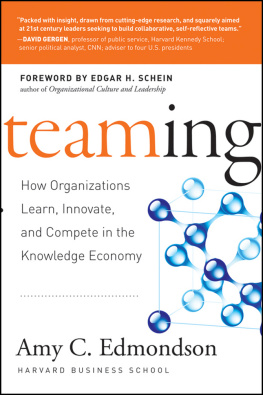Note on the Ebook Edition
For an optimal reading experience, please view large tables and figures in landscape mode.
This ebook published in 2015 by
Kogan Page Limited
2nd Floor, 45 Gee Street
London EC1V 3RS
United Kingdom
www.koganpage.com
Sheila Keegan 2015
E-ISBN 978 0 7494 7255 9

Fear doesnt shut you down; it wakes you up. VERONICA ROTH
I n this book we will explore the emotion of fear within large organizations: how it arises, how it can be recognized and how we can deal with it. The book is in two parts. Part One explores the paradoxical nature of fear itself and its various manifestations in the workplace. We examine how a widespread culture of fear has emerged, fuelled largely by the recent economic downturn, and how it has spread its tentacles throughout many organizations and indeed through society as a whole. In particular, we will examine how fear can infiltrate workplaces and the impact it can have on employees, at all levels of the organization.
Part Two explores the ways in which we can both combat the effects of fear and tap into its energy. By examining different approaches to utilizing fear we can harness it for our own benefit, particularly in relation to creativity, productivity, innovation and risk-taking within organizations. Most importantly, we can attempt to create healthy organizations in which people want to work.
We will examine some of these issues within the context of working life in a range of organizations. The book is based in part on commissioned research and organizational change projects carried out by Campbell Keegan Ltd, a business consultancy that I have jointly run, along with my co-director Rosie Campbell, for the last 30 years. I also include academic input from books, papers, conferences and innumerable conversations with colleagues working in the areas of research and organizational change over the years.
My aim in writing this book is to encourage thoughts, comments and discussion among those who work with and within organizations so that we can share experiences and further develop ideas on the growth and nature of organizations. We are moving out of the time of austerity, yet many of us still carry the baggage of anxiety and, all too often, fear, instilled by the recession. My initial aim was to direct this book towards psychologists, research practitioners and those who work in organizational change. However, as I wrote, I came increasingly to the view that, as almost all of us work in, or interact with, organizations, it may have broader relevance.
The book draws on both the academic and the practical. It includes some theory and a scattering of case studies. It is also coloured by my ongoing interest in the complexity sciences, in particular the work of Professor Ralph Stacey Of course, both perspectives are important and this is a question of perspective. How we work with these different perspectives is something we will return to throughout this book.
Much of Campbell Keegans work over the years has involved qualitative research. This is a form of research seeking useful directions to explore and pursue in order to help solve problems or create new concepts. Qualitative research is a form of emergent inquiry that allows the researcher to explore, hypothesize and experiment. It is therefore concerned less with measurement and statistics (as is quantitative research).
However, qualitative and quantitative perspectives are two sides of the same coin. Overemphasis on measurement and statistical significances skews understanding, just as exclusive attention to qualitative findings potentially distorts understanding in a different way. Both elements need to be in balance. As we will see, this is particularly relevant in the context of organizational development as well as the development of new ideas, products or services in a range of sectors.
The recession has eased, but its psychological effects may well be with us for some years to come. Both employers and employees are still wary. In many organizations tough decisions had to be made to ensure the companys survival and it will take time for the scars to heal. It is perhaps not a gross overstatement to say that, just as the Second World War shaped the attitudes of a generation, so too the recent recession will shape the attitudes, behaviours and fears within organizational life for some decades to come.
We will start by briefly introducing the topic of fear within organizations. Although we will examine fear in many different contexts throughout this book and probe into its manifestations and effect on different aspects of our lives, fear in organizations is our prime concern. This is not a new subject you could argue that there is not an organization in the world that does not have at least some employees who are fearful on some occasions but research from around the world provides strong evidence that fear is a more invasive and disabling influence than ever before. Fear is part of our human lot, for better and worse, and we cannot avoid it. However, when we get to the point where significant numbers of employees express the view that work is a source of fear and anxiety, we have to ask ourselves: What is going on here? How have we created this situation? How is it possible that working environments that should provide us at the very least with an income, job satisfaction and a sense of community become places to avoid or even to dread? It must be that fear improves employees performance, their thinking, their speed, their creativity. Well, on the whole, no , it doesnt. Fear is much more likely to inhibit productivity than to foster it. So, why has a culture of fear developed? This is one of the key issues we will explore in this book.
You may ask, Is fear that big a deal in contemporary life In developed countries we are unlikely to be savaged by wild animals, die of starvation on be unable to access medical care. This is a big question and one that is not easily answered. Fear is a very powerful force and it is one that is difficult to define. Or at least it is difficult to find a way of describing it that everyone would agree with. What one person experiences as fear might be brushed away by another as a minor irritant.
The sociologist Barry Glassner describes America as engrossed with fear.
He claims that three out of four Americans say they feel more fearful today than they did 20 years ago but, he believes, it is our perception of danger that has increased, not our actual level of risk. He points out that the huge amount of attention given to airline safety is disproportionate to the risk. Hazards that kill and injure many more people receive much less attention. In the mid 1990s, while the press obsessed over airline accidents which resulted in fewer than a dozen deaths in the best years and a few hundred in the worst more than 5,000 Americans died in work-related injuries each year. It seems that some risks are simply more sexy than others. If the issue is that we overestimate fear, that we see fear where there is none, perhaps we simply need to address our perceptions of fear rather than trying to avoid situations that induce it.
The climate of fear
Fear and uncertainty are the backdrop against which this book is set, and fear is the emotion that many of us try hardest to avoid; although paradoxically we may also court it. Fear reaches back into the origins of mankind and, at the same time, it lurks in the dark alleyways of our 21st-century minds, biding its time, waiting to pounce in our moments of weakness. It can be a figment of our imagination or it can be all too real. Sometimes it is unclear which it is or maybe it is both at the same time. Fear is an emotion that is widely viewed as a pariah. Many of us feel afraid of fear itself, but fear can be our friend as well as our foe. It can sharpen our senses. It can steer us through danger. Whatever you may currently think about fear, my aim is to convince you that fear is not all bad news. Fear is a chameleon. It surprises us. It shocks. But, paradoxically, it can help us to perform to the best of our abilities, sometimes to a level way beyond our wildest dreams. In certain circumstances it can even make us superhuman. We will examine the conundrum of fear; how it can be so ubiquitous, so adaptable and so scary, all at the same time.
Next page
